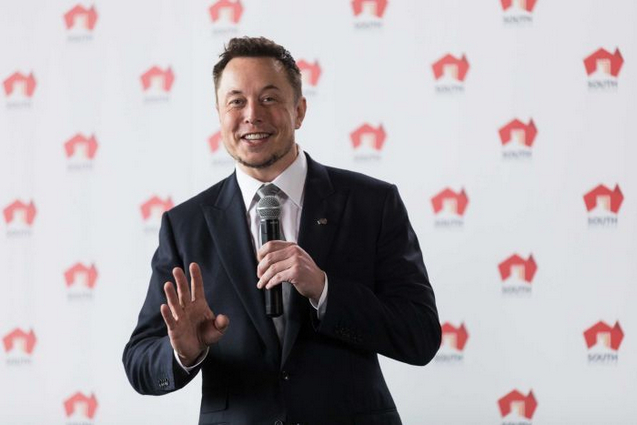Tesla's big battery is launched in South Australia (ABC News)
Key points
|
And according to a new report by the Australian Energy Market Operator (AEMO), it's outperforming coal and gas generators on some key measures
Here's a look at how it's performed and its potential impact on the future of power in Australia.
The big battery could stop another statewide blackout
In September 2016, South Australia was plunged into darkness when storms tore through transmission lines.
The faults in the transmission system prompted several wind farms to unexpectedly power down.
With that sudden loss of generation, South Australia immediately began drawing more power across the interconnector to Victoria, which overloaded and switched off.
 |
| Transmission towers that were downed in strong winds near Melrose in South Australia in 2016. (ABC News: Tom Fedorowytsch) |
AEMO is now working on a new protection scheme, and Tesla's big battery will play a part.
It aims to detect high flows on the interconnector and trigger the battery to start discharging its full output as quickly as possible, while shedding power to homes and businesses if required.
And future batteries could also be a part of the scheme in the future.
The battery is capable of responding more quickly to problems than coal, gas or hydro
According to AEMO the speed, precision and agility of the battery is unprecedented in dealing with both major power system disturbances and day-to-day frequency variations.
And on December 18 it got the chance to prove it, when a coal generator in New South Wales tripped.
The battery was able to respond to the sudden loss of 689 megawatts of generation within a fraction of a second.
A gas or steam turbine might have taken minutes to respond and adjust.
 |
| The substation near Jamestown in July this year, before construction began on the giant battery. (ABC News: Nick Harmsen) |
FCAS requires providers to keep a little bit of power in reserve — which the market operator can use to help correct the supply/demand balance in response to minor changes in load or generation.
Some FCAS services are reserved for use in a major event — like a major power station fire, a transmission line tripping or a big industrial load switching off.
Until Tesla's big battery switched on, FCAS services in Australia had only ever been provided by traditional coal, gas, diesel and hydro generators.
It has saved electricity customers cold hard cash
According to the report, early evidence shows the battery is helping cut some of the costs borne by South Australian electricity users.
With a high penetration of wind farms — which until recently haven't offered FCAS — the state has sourced much of it back up power from generators on the eastern seaboard.
However, when the interconnector to Victoria is under maintenance AEMO is required to source some frequency control within the state.
Before the Tesla battery, there were only four gas-fired power stations offering those services.
 |
| Elon Musk's Tesla giant battery contributes to the backup power market. (AAP: Ben Macmahon) |
To put it in context, on a single day in October 2016, the Australian Energy Regulator found the cost of regulation services within SA exceeded $4.5 million, while buying these services has cost the state more than $50 million since 2015.
But with the battery now offering FCAS services at lower prices, the South Australian market has not seen similar price spikes over Summer.
It has been a money maker
According to analysis from consulting firm Energy Synapse, the Hornsdale Power Reserve has made an estimated $1.4 million so far by buying power when prices are low and selling when they're high.
The overwhelming majority of this money – 95 per cent - was made on five very hot days in January and February, when prices were at their most volatile.
Interestingly, the Energy Synapse analysis estimates that the battery actually lost money in the energy market on 57 days.
But that doesn't include the money made from FCAS.
It's also not entirely clear how Neon's money-making arbitrage strategy works, given it also owns the neighbouring Hornsdale Wind Farm, which is contracted to provide energy and shares a grid connection point.
Energy Synapse's founder Marija Petkovic says the battery's operators will need to be careful to avoid needlessly cycling it for little financial gain.
"This is an important consideration because the lifetime of a battery is strongly related to how many times it is cycled," she wrote.
But, more financial incentives for battery owners should be introduced
The AEMO found the battery provided high-quality back up power and could respond more quickly to a major problem than traditional coal, gas or hydro generators.
But it said market didn't adequately recognise or reward the agility of batteries.
It's flagged the possibility of new, faster moving frequency control markets, like those offered overseas, to make sure Australia maximises the benefit of new batteries.
Links
- Frydenberg pressures AGL to sell Liddell power station to Alinta
- SA Liberals tight-lipped on Musk battery storage plan
- 'Two billionaires duking it out': SA to house world's biggest battery (again)
- Stunning Drops In Solar, Wind Costs Mean Economic Case For Coal, Gas Is ‘Crumbling’
- Charging Ahead: How Australia Is Innovating Battery Technology
- Natural Gas Killed Coal – Now Renewables And Batteries Are Taking Over
- Plunging Costs Make Solar, Wind And Battery Storage Cheaper Than Coal
- A Month In, Tesla’s SA Battery Is Surpassing Expectations
- 'All Happening Very Quickly': Tesla Battery Sends A Jolt Through Energy Markets
- Tesla’s Enormous Battery In Australia, Just Weeks Old, Is Already Responding To Outages In ‘Record’ Time
- 'History In The Making': Tesla Switches On World's Largest Battery In SA

No comments :
Post a Comment